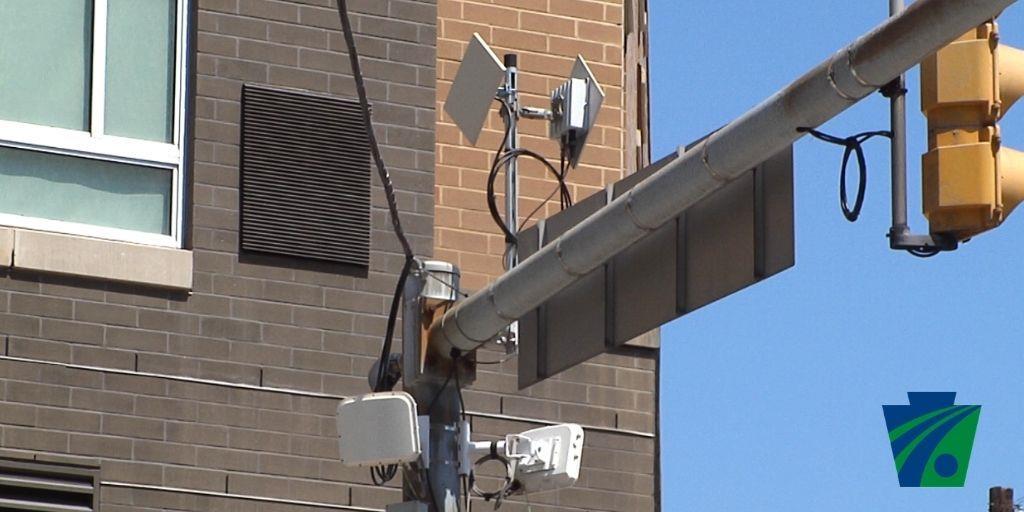
PennDOT's ongoing initiative to deploy adaptive traffic signal technology took a significant step forward recently with the opening of bids for Phase 1 of the adjacent corridor improvement portion of the Interstate 76 (I-76) Corridor Comprehensive Transportation Management Plan.
The apparent low bidder was Armour and Sons Electric of Langhorne, Bucks County. They will be installing adaptive signal equipment at 50 locations along the State Route 23 and Gulph Road corridors on the west side of the Schuylkill River.
"The equipment should be installed and operational by early September, and we'll use that do the pilot evaluation of PennDOT's management of corridors," said Steve Gault, P.E., chief of the Traffic Systems Management and Operations (TSMO) Arterials and Planning Section.
The I-76 Corridor plan aims to alleviate tough congestion issues along the Schuylkill Expressway that carries more than 130,000 vehicles a day in Montgomery County. In addition to the adaptive signals on routes adjacent to the expressway, the plan calls for part-time shoulder running, variable speed limits, ramp metering and multi-modal improvements.
PennDOT is also working on upgrades to traffic signals along Henry Avenue in Philadelphia and future segments of the overall plan include traffic signal upgrades along both Ridge Pike in Montgomery County and Ridge Avenue in Philadelphia. The overall plan envisions upgrades at roughly 160 locations.
Across Pennsylvania, adaptive signal technology has been installed at approximately 650 locations, Gault said.
Adaptive Signal Control Technology (ASCT) adjusts signal timings in real time based on current traffic conditions. Deployment of the technology is championed by the Federal Highway Administration's (FHWA) Every Day Counts Program (EDC) and the Pennsylvania State Transportation Innovation Council (STIC).
As part of that effort, PennDOT continues to work on developing Automated Traffic Signal Performance Measures (ATSPMs) that involve the use of data to analyze and optimize traffic signal performance. The STIC's Safety and Traffic Operations Technical Advisory Group also continues to work on guidance and training to help users interpret data and use it to produce better signal timing and reduce congestion. ATSPMs will play a role in evaluating PennDOT ownership and management of traffic signals for the I-76 corridor projects.
And PennDOT continues to help fund local traffic signal improvement through the Green Light-Go Program.
"Using adaptive signal technology is a case-by-case decision on where it is appropriate," Gault said. "It's a tool in the tool box … and we need to look at each one to see if it is the right tool to apply in that situation."
ABOUT THIS BLOG
Did you know PennDOT is directly responsible for nearly 40,000 miles of highway and roughly 25,000 bridges? We oversee programs and policies affecting highways, urban and rural public transportation, airports, railroads, ports and waterways, in addition to administering the state's more than 11 million vehicle registrations and 8.8 million driver's licenses.
So, how do we do what we do? And how can we help you travel in Pennsylvania — whether it be for business or leisure — in safe and enjoyable manner? Read PennDOT Way to learn more about the department, what we do, and how and why we do it.
TAGS
50-Year Anniversary, 511PA, Aggressive Driving, Airports, Autonomous Vehicles, Bicycles, Bridges, Child Safety, Community Relations, Construction, COVID-19, Distracted Driving, District 1, District 10, District 11, District 12, District 2, District 3, District 4, District 5, District 6, District 8, District 9, DOTcom, Driver and Vehicle Services, Emergency Responders, Employment, Equity, FAQ Friday, Human Trafficking, Impaired Driving, Innovations, Live Free Ride Alive, Maintenance Monday, Motorcycles, Older Drivers, PA Motorcycle Safety Program, Pedestrians, PennDOT Connects, Ports, Public Transit, Railroads, REAL ID, Road MaP, Roadside Beautification, Rural Roads, Safety, School Buses, Seat Belts, State Transportation Innovation Council (STIC), Sustainability, Teen Drivers, Throwback Thursday, Transportation Funding, Travel in PA, Welcome Centers, Winter, Work Smart, Work Zone, Yellow Dot
LATEST POSTS
PennDOT Continues Sharing, Updating Resources for Local Governments to Pursue Bipartisan Infrastructure Law Funding Opportunities
Norwin High School Wins 2024 ‘Innovations Challenge’
Demo Complete: I-95 CAP Project in Center City Philadelphia
PennDOT Archeologist Connects Past, Present, and Future
Lehigh Valley DUI, Highway Safety Task Force Hosts Law Enforcement Seminar
ARCHIVES
2024
2023
2022
2021
2020
2019
2018
2017

